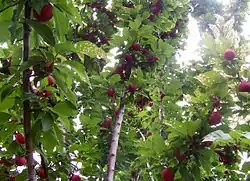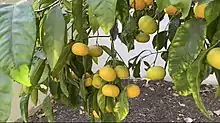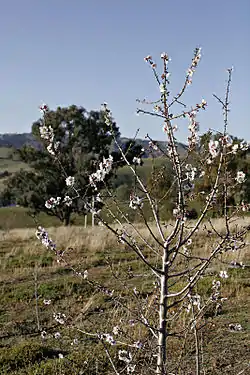Fruit tree
A fruit tree is a tree which bears fruit that is consumed or used by humans and some animals — all trees that are flowering plants produce fruit, which are the ripened ovaries of flowers containing one or more seeds. In horticultural usage, the term "fruit tree" is limited to those that provide fruit for human food. Types of fruits are described and defined elsewhere (see Fruit), but would include "fruit" in a culinary sense, as well as some nut-bearing trees, such as walnuts.



The scientific study and the cultivation of fruits is called pomology, which divides fruits into groups based on plant morphology and anatomy. Some of those groups are pome fruits, which include apples and pears, and stone fruits, which include peaches/nectarines, almonds, apricots, plums and cherries.[1]
Examples of fruit trees
- Abiu
- Almond
- Amla (Indian gooseberry)
- Apple
- Apricot
- Avocado
- Bael
- Ber (Indian plum)
- Carambola (starfruit)
- Cashew
- Cherry
- Citrus (orange, lemon, lime, etc.)
- Coconut
- Crab apple
- Damson
- Durian
- Elderberry
- Fig
- Grapefruit
- Guava
- Jackfruit
- Jujube
- Lemon
- Lime
- Loquat
- Lychee
- Mango
- Medlar
- Morello cherry
- Mulberry
- Olive
- Orange
- Pawpaw, both the tropical Carica papaya and the North American Asimina triloba
- Peach and nectarine
- Pear
- Pecan
- Persimmon
- Plum
- Pomelo
- Quince
- Pomegranate
- Rambutan
- Sapodilla (chikoo)
- Soursop
- Sugar-apple (sharifa)
- Sweet chestnut
- Tamarillo
- Ugli fruit
- Walnut
- Water Apple
See also
References
- Editors, .; Singha, Suman (2003), Concise encyclopedia of temperate tree fruit, New York: Food Products Press, pp. 3–5, ISBN 978-1-56022-941-4CS1 maint: extra text: authors list (link) CS1 maint: numeric names: authors list (link)
